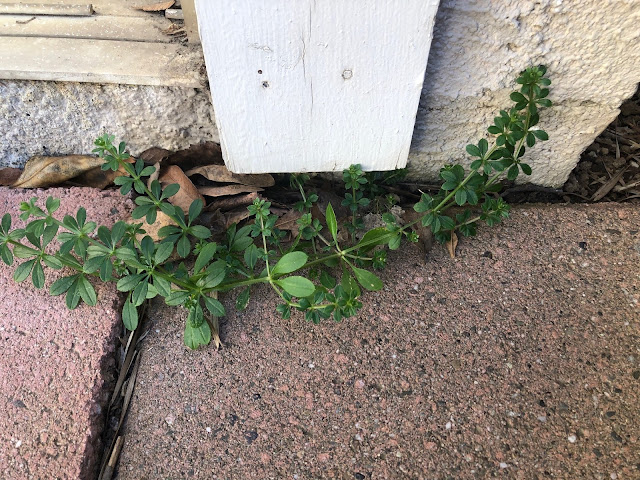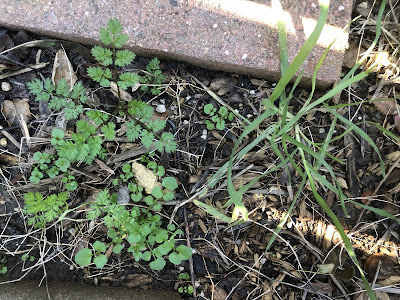
Get them out now for an easier spring

|
|
Bedstraw, a prickly weed hated by pet owners, already has grown quite a bit against a west-facing wall. But not for long. (Photos: Kathy Morrison)
|
The popular comic Pearls Before Swine last May had a strip that still decorates my refrigerator. In the first panel, Rat (the snarky character) asks Goat (the sensible one) what he's doing. Here's how the rest of it plays out:
Goat: Pulling the weeds in my garden.
Rat: We haven't had to do that at all in our garden this year.
Goat: Oh, yeah? What are you growing?
Rat: Weeds.
The last panel shows Rat talking to another friend, Pig. "No one appreciates my gardening tips," he says.
So ... unless you're like Rat and plan to have a garden of weeds this year, here's my gardening tip: Get them out while they're small.
Our weather has been just nice enough that weed seeds, fed by December's rains, are now sprouting all over. It can be hard to identify weeds without their flowers, but now is when it's easiest to get rid of them.

|
|
A sampler of the types of weeds you may already see in the
garden, including little bittercress (lower left and a small one
top center) and grasses. The carrot-looking plant top left also is a weed. |
-- They hog water and nutrients that could be going to wanted plants.
-- They harbor pests (insects and rodents) and pathogens that can sneak up on seedlings and transplants.
-- The roots only grow stronger and tougher to eradicate.
-- Allowed to grow and flower, some weeds then spread by underground runners, tubers or rhizomes, or burrs that attach to pets' fur. Others produce allergens.
The UC Integrated Pest Management Program (UC IPM) filmed a great talk on weeds last year with John Roncoroni, a retired UCCE weed science farm adviser. He discusses ways to identify weeds, but also covers the why of controlling weeds, and priorities for tackling them. Here's the link to the YouTube video . (It's about 39 minutes.)
So whether you prefer using a sharp hoe, or a trowel or specialized weeding tool, tackle the weeds now -- before you need a shovel.
Or give up, like Rat, and just grow weeds.
----
Here are links to some of our previous posts on weeds:
Is this the worst weed in Sacramento? (nutsedge)
Eeek! It's weed season already (5 problem plants to get rid of now)
Comments
0 comments have been posted.Sacramento Digs Gardening to your inbox.
Sites We Like
Garden Checklist for week of April 21
This week there’s plenty to keep gardeners busy. With no rain in the immediate forecast, remember to irrigate any new transplants.
* Weed, weed, weed! Get them before they flower and go to seed.
* April is the last chance to plant citrus trees such as dwarf orange, lemon and kumquat. These trees also look good in landscaping and provide fresh fruit in winter.
* Smell orange blossoms? Feed citrus trees with a low dose of balanced fertilizer (such as 10-10-10) during bloom to help set fruit. Keep an eye out for ants.
* Apply slow-release fertilizer to the lawn.
* Thoroughly clean debris from the bottom of outdoor ponds or fountains.
* Spring brings a flush of rapid growth, and that means your garden is really hungry. Feed shrubs and trees with a slow-release fertilizer. Or mulch with a 1-inch layer of compost.
* Azaleas and camellias looking a little yellow? If leaves are turning yellow between the veins, give them a boost with chelated iron.
* Trim dead flowers but not leaves from spring-flowering bulbs such as daffodils and tulips. Those leaves gather energy to create next year's flowers. Also, give the bulbs a fertilizer boost after bloom.
* Pinch chrysanthemums back to 12 inches for fall flowers. Cut old stems to the ground.
* Mulch around plants to conserve moisture and control weeds.
* From seed, plant beans, beets, cantaloupes, carrots, corn, cucumbers, melons, radishes and squash.
* Plant onion sets.
* In the flower garden, plant seeds for asters, cosmos, celosia, marigolds, salvia, sunflowers and zinnias.
* Transplant petunias, zinnias, geraniums and other summer bloomers.
* Plant perennials and dahlia tubers for summer bloom.
* Mid to late April is about the last chance to plant summer bulbs, such as gladiolus and tuberous begonias.
* Transplant lettuce seedlings. Choose varieties that mature quickly such as loose leaf.